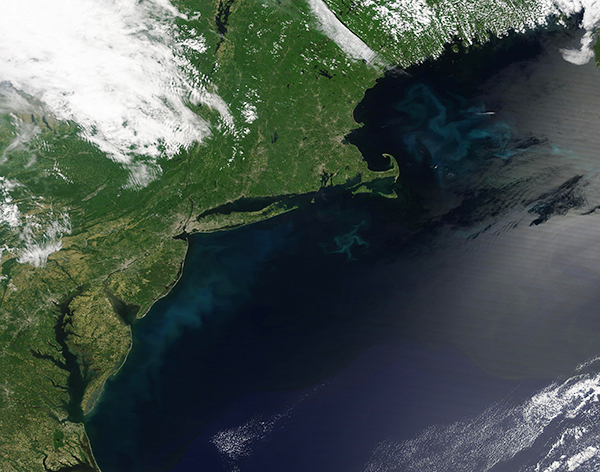Images
June 8, 2022 - Blooms off the East Coast of the United States
Tweet
Swirls of color lingered in the Atlantic Ocean off the Mid-Atlantic and Northeastern United States through early June 2022. The Moderate Resolution Imaging Spectroradiometer (MODIS) on board NASA’s Terra satellite acquired a true-color image of the scene on June 6.
Several swaths of ocean color are visible in this image. A long, sinuous, cloudy-appearing length of color stretches in the deep blue Atlantic parallel to the coast of Maryland, Delaware, New Jersey, and New York. A fanciful, brighter jewel-toned swirl sits south of Massachusetts while a larger swirl colors the Gulf of Maine, reaching from east of Massachusetts north to Maine.
These colors are produced by massive colonies of phytoplankton, which are microscopic plant-like organisms that live in these waters year-round in small numbers. When conditions are favorable — correct water temperature, daylight length, and nutrient levels—phytoplankton can reproduce explosively, creating large blooms that can easily be viewed from space.
A silver-toned, mirror-like tint overlies some of the bloom in the Gulf of Maine and stretches south and westward over the open Atlantic Ocean. This gleam comes from an optic phenomenon known as “sunglint”. Sunglint occurs when sunlight reflects off the surface of water at the same angle that a satellite sensor views it. The result is a mirror-like reflection of sunlight off the water and back at the satellite sensor.
Phytoplankton blooms are common in most of the world’s oceans and occur regularly in the Atlantic Ocean off of the East Coast of the United States in spring and summer. The color, extent of the bloom, and location all change with time, currents, and water conditions. Even the species of phytoplankton play a role—different species may lend different colors to the bloom.
On May 17, 2022, NASA’s Earth Observatory published an image of phytoplankton blooming along the Mid-Atlantic region that was acquired that same day by the Visible Infrared Imaging Radiometer Suite (VIIRS) instrument on the NOAA-20 satellite. At that time, the bloom was more intensely colored and larger than on June 6. The publication gives an excellent discussion of the cause of this particular bloom, as well as provides a discussion—and a video—of the importance of phytoplankton as a primary fuel to life in the ocean. To view the Earth Observatory article, click here.
Image Facts
Satellite:
Terra
Date Acquired: 6/6/2022
Resolutions:
1km (991.9 KB), 500m (2.7 MB), 250m (1.8 MB)
Bands Used: 1,4,3
Image Credit:
MODIS Land Rapid Response Team, NASA GSFC
Tweet
Swirls of color lingered in the Atlantic Ocean off the Mid-Atlantic and Northeastern United States through early June 2022. The Moderate Resolution Imaging Spectroradiometer (MODIS) on board NASA’s Terra satellite acquired a true-color image of the scene on June 6.
Several swaths of ocean color are visible in this image. A long, sinuous, cloudy-appearing length of color stretches in the deep blue Atlantic parallel to the coast of Maryland, Delaware, New Jersey, and New York. A fanciful, brighter jewel-toned swirl sits south of Massachusetts while a larger swirl colors the Gulf of Maine, reaching from east of Massachusetts north to Maine.
These colors are produced by massive colonies of phytoplankton, which are microscopic plant-like organisms that live in these waters year-round in small numbers. When conditions are favorable — correct water temperature, daylight length, and nutrient levels—phytoplankton can reproduce explosively, creating large blooms that can easily be viewed from space.
A silver-toned, mirror-like tint overlies some of the bloom in the Gulf of Maine and stretches south and westward over the open Atlantic Ocean. This gleam comes from an optic phenomenon known as “sunglint”. Sunglint occurs when sunlight reflects off the surface of water at the same angle that a satellite sensor views it. The result is a mirror-like reflection of sunlight off the water and back at the satellite sensor.
Phytoplankton blooms are common in most of the world’s oceans and occur regularly in the Atlantic Ocean off of the East Coast of the United States in spring and summer. The color, extent of the bloom, and location all change with time, currents, and water conditions. Even the species of phytoplankton play a role—different species may lend different colors to the bloom.
On May 17, 2022, NASA’s Earth Observatory published an image of phytoplankton blooming along the Mid-Atlantic region that was acquired that same day by the Visible Infrared Imaging Radiometer Suite (VIIRS) instrument on the NOAA-20 satellite. At that time, the bloom was more intensely colored and larger than on June 6. The publication gives an excellent discussion of the cause of this particular bloom, as well as provides a discussion—and a video—of the importance of phytoplankton as a primary fuel to life in the ocean. To view the Earth Observatory article, click here.
Image Facts
Satellite:
Terra
Date Acquired: 6/6/2022
Resolutions:
1km (991.9 KB), 500m (2.7 MB), 250m (1.8 MB)
Bands Used: 1,4,3
Image Credit:
MODIS Land Rapid Response Team, NASA GSFC




